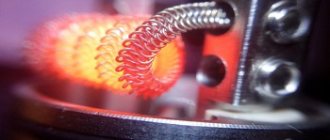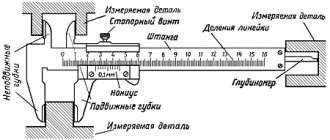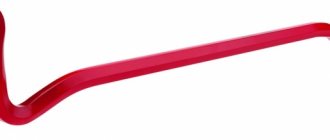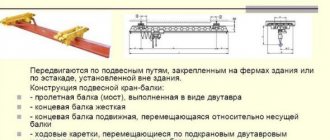Nichrome is an alloy of 80% nickel and 20% chromium with a melting point close to 1400 C. It is gray in color and is resistant to corrosion. Due to its high resistance and difficult oxidation at high temperatures, it is widely used in manufacturing. Nichrome wire is a resistive material that is used to improve the high temperature performance of many materials at very high temperatures where other conductive metal elements cannot operate.
Stamps
Nichrome is a heat-resistant alloy, has high electrical resistance, a low temperature coefficient of resistance, and significant corrosion resistance to air or other gaseous media at high temperatures. It also has satisfactory manufacturability (cold ductility, weldability) - nichrome wire, thread, tape, strip, rods and other semi-finished products can be obtained from this material; sufficient heat resistance - the ability to withstand mechanical loads without significant deformation, without collapsing at high temperatures. Oxides that are stable at high temperatures are formed on the surface of these alloys. The oxide film has a high density. These two factors ensure the high heat resistance of this precision material.
The most widely used brands are X20H80 and X15H60. Nichrome Х20Н80-Н, Х20Н80-VI, Х15Н60-Н, Х15Н60-VI are also used. The marking of these alloys is deciphered as follows: the letter denotes a chemical element, the number following it is the average mass fraction of this element in the alloy. For example, nichrome X20N80 contains 20-23% chromium (Cr) and about 80% nickel (Ni), X15N60 - 15-18% chromium (Cr) and about 60% nickel (Ni). The letters VI at the end of the brand indicate that this material was manufactured in a special way, namely, using vacuum induction melting. The letter H at the end of the brand indicates that the composition includes zirconium, which increases the reliability of the heater made of nichrome by increasing resistance at maximum operating temperature.
The chemical composition of grades Х20Н80, Х20Н80-Н, Х20Н80-VI and Х15Н60, Х15Н60-Н, Х15Н60-VI is regulated by the GOST standard 10994-74.
Examples of where you can get nichrome alloy
There are several ways to get nichrome. Each of them differs in the ease of obtaining and the quality of the material, but it is worth considering all possible options.
Ordering material
Nichrome, kanthal, nickel, and wire of some other alloys are sold in wholesale stores. The assortment provided by wholesalers is very large; you can order wire of any desired alloy of any cross-section and thickness. Relevant information about available stores can be found by calling the city's information service, or using an Internet search.
Even if the customer lives in a remote locality where the supplier’s organization is not located, you can request delivery, choosing the most convenient of the proposed options.
Heat capacity, linear expansion, density and thermal conductivity of nichrome
The table presents the following physical properties of nichrome: specific heat at 25°C, average coefficient of thermal linear expansion in the temperature range from 20 to 1000°C and density of nichrome at 25°C.
It should be noted that the considered grades of nichrome have similar values of physical properties. The density of nichrome is in the range of 8200...8660 kg/m 3 and increases with increasing nickel content in the alloy. The coefficient of thermal linear expansion of nichrome at 20...1000°C has the value (17...18)·10 -6 deg -1. The specific heat capacity of nichrome, depending on the brand, is 440...460 J/(kg deg).
Specific heat capacity, linear expansion and density of nichrome
| Nichrome brand | C, J/(kg deg) | α·10 6 , deg -1 | ρ, kg/m 3 |
| Nichrome (10%Cr + 90%Ni) | 460 | 18 | 8660 |
| Х15Н60 | 460 | 17 | 8200 |
| Х20Н80-Н | 440 | 18 | 8400 |
| Nikrothal 80 | 460 | 17,2 | 8300 |
The thermal conductivity of nichrome is similar in value to the thermal conductivity of stainless steel. The table shows data on the thermal conductivity of the considered alloys at various temperatures in the range from 0 to 600°C.
The thermal conductivity of nichrome increases when heated. With increasing nickel content in the alloy, its thermal conductivity coefficient increases. For example, an alloy containing 10% Cr and 90% Ni has the highest thermal conductivity of the alloys considered, equal to 17.4 W/(m deg) at 20°C.
Cost of nichrome
Based on geography, the global nichrome alloy market can be classified into Asia Pacific, Europe, North America, Latin America, and the Middle East and Africa. North America and Europe are the main markets for nichrome alloys, driven by the growth of the aerospace and electronics industries. Nichrome manufacturing companies in Asia Pacific and Latin America are investing heavily in nichrome research and development in Asia.
The cost of nichrome products in the form:
- Wire 0.8 mm Х20Н80 – 1,990 rub./kg;
- Wire 2.0 mm Х20Н80 -2,050 rub./kg;
- Tape #1.0x15 mm Х20Н80 – 1,990 rub./kg;
- Nichrome wire 1.5 mm X15N60 – RUB 1,590/kg.
Nichrome Bibus Metals
The major players operating in the global nichrome alloys market are American Elements, Bibus Metals, VDM Metals, Crown Alloys, Wickeder Westfalenstahl GmbH, Tri Star Metals and others. These companies constitute a significant share of the nichrome alloys and scrap market, thus the market is highly competitive.
Russian producers of nichrome: Volgograd Steel Wire Rope Plant, GRACE-1000 (Moscow), Western Ural Industrial Supply (Perm), Index-VK (Ekaterinburg), Kamensk-Uralsky Plant, Metallokomertsiya (Moscow), Prommet (Moscow), Promsnabmetall AG (Moscow ), Ural Precision Alloys Plant.
Distinctive characteristics
Among the most popular electrical products on the market is nichrome wire. This component of electric heating technology is extremely high, which allows it to have a wide demand.
An important feature of the metal is its resistance to high-temperature oxidation under normal and aggressive conditions. Chrome plays a key role here
The element forms a corresponding oxide film on the surface, which performs a protective function. It is also responsible for the corresponding dark color of the material, which is replaced by a characteristic white-gray when the oxidized layer is mechanically removed.
It is worth noting that direct contact with acids still destroys it, even more than corrosion-resistant tungsten.
The two-component alloy has no magnetic characteristics. They arise for its multicomponent modifications, but have weakened indicators.
Nichrome wire is rigid and does not lend itself to simple force.
We systematize information on how to identify nichrome wire, mainly how to distinguish it from externally similar materials:
- White is the color of new metal, dark is the color of previously worked metal.
- Negative or minimal magnetism.
- Rigidity.
- Destruction by acids, resistance to oxidation under the influence of high temperatures.
Where is nichrome wire used?
Plasticity, resistance to aggressive substances and high yield strength are used by nichrome in industrial production and a number of industrial areas where electric heating furnaces are widely used. The alloy has also found application in electric furnaces, the heating temperature of which is extremely high.
Wire is also used in other areas:
- in homemade welding machines;
- in ovens for drying and firing;
- for machines cutting foam plastic;
- in the heating system of car windows and mirrors;
- in devices where an increased degree of reliability is required, etc.
This property of the alloy, such as strength, has provided nichrome wire with a place in all environments where chemicals, heat and high temperatures are indispensable.
Tungsten wire and its features
Basic properties of tungsten
Tungsten is a refractory metal that is used in the manufacture of heat-resistant alloys. It has a high density, its density reaches 19.3 g/cm3. Tungsten begins to melt at 3395°C and boils at 5500°C, while its evaporation rate is low. As for the electrical conductivity of this metal, it is approximately 1/3 of the value of the same parameter for copper. Tungsten is brittle at low temperatures and also has low oxidation resistance. This metal can be processed by pre-heating it. Externally, tungsten is similar to steel.
Tungsten wire production
The most popular long products made from tungsten are wire. It is produced in accordance with GOST 25501-82. Tungsten wire is a semi-finished product, the cross-section of which remains constant along its entire length. It is made by pressing or drawing.
Since tungsten has low technological plasticity, to increase this property it is heated, which in no way affects the strength of the material, which still remains high. Only after such procedures can wire be obtained by any method of processing under pressure. Supplied in coils or coils.
Powder metallurgy methods are often used to produce tungsten blanks, which makes it possible to improve some of the quality and properties of tungsten. A shtabik is a semi-finished product from which wire is made. It is first heated, and then a special rotary forging machine is used to carry out the forging. This is how tungsten rods are obtained, the diameter of which is 2-3 mm. Wire is obtained from them by drawing in a heated state. The diameter of the resulting long rolled metal is represented by a number of standard values up to 0.3 mm.
Scope of application of tungsten wire
The electrical and electronics industries are the main consumers of pure tungsten. The metal is indispensable in cases where low vapor pressure is required at operating temperatures up to 2500 °C. Tungsten wire is a material for heating elements of furnaces operating in a hydrogen, neutral or vacuum environment, heating up to 3000 °C. Thermocouples are made from this grade of metal. For their manufacture, tungsten-rhenium wire with a rhenium content of 5 and 20% (VR 5/20, VR5/20, VR5/VR20) is used.
More information about the use of tungsten wire grades VA, VM, VRN, VT-7, VT-10, VT-15 can be found by reading GOST 18903-73.
Advice from professionals
Experts consider the first switch-on to be one of the most significant moments on which the performance of the system being installed depends. Its algorithm is presented below:
- First day. The temperature controller is set to 20°C.
- Next 3 days. The temperature increases by 2°C every day.
- Fifth day. The heated floor is ready for full use.
If the installed equipment does not heat, then first of all the owner of the premises needs to check whether the cable is broken using a multimeter
When measuring resistance using this device, it is important to consider that it should not deviate by more than 5% from the values declared by the manufacturer. If there are serious discrepancies, there is only one solution left - to find damage or a break, “armed” with a device for searching for hidden wiring in the walls. Having found the problem area, you can begin to repair it (it is better not to solder, but to use a coupling that provides the most reliable connection)
Having found the problem area, you can begin to repair it (it is better not to solder, but to use a coupling that provides the most reliable connection).
Another common cause of underfloor heating malfunction is the temperature regulator, or more precisely, loosening of the contacts of its terminal block. To repair the device, just remove its front cover and carefully tighten the screw connections.
In conclusion, it remains to add that experts do not advise saving on the cost of purchased products. A cheap cable can quickly become unusable, which is explained by its low service life. Considering this circumstance, it is better to buy high-quality products from the top ones with the best reviews. Having made such a choice, there is no doubt that warmth and comfort in your home will be ensured, and for a very long time.
To see the difference between a heating cable and a heating mat, see the following video.
Where to get nichrome wire
The product is sold in rolls (reels, coils) or in the form of tape. Where to buy or get nichrome products? Let's consider all possible options:
- Order from the organization that manufactures the product. You can find out the addresses of such enterprises in information desks on services and goods that are available in large populated areas. The operator will tell you where to buy and give you phone numbers. Information about manufacturers can be found on the Internet.
- Purchase from a specialty store. This could be a store that sells radio components, materials for designers and craftsmen like “Skillful Hands,” etc.
- Buy from private traders selling spare parts, radio components and other small metal items.
- In a regular hardware store.
- At a flea market or flea market in some old device. For example, in the laboratory rheostat known from physics lessons.
- You can find nichrome wire at home. The spiral of the electric stove is made from it.
What is Resistance Heating Alloy
Resistive materials are materials that heat up to high temperatures when current passes through them.
The reliability, quality and technical characteristics of heating elements depend on the composition of the material.
The main types of resistive alloys include:
- Nichromes are alloys of nickel and chromium.
- Ferkhali - alloys of iron, chromium and aluminum.
- Multicomponent alloys, in which, in addition to chromium, aluminum, iron, alloying elements are added - copper, manganese, silicon, titanium.
The melting point of multicomponent alloys is 1500°C, and the service life of heating elements is 2-3 times longer than nichrome products.
What is nichrome and what is its value?
Nichrome is a special alloy with a high concentration of chromium and nickel. The composition also includes iron, aluminum, silicon, manganese and other chemical elements, the combination of which gives the metal unique characteristics.
A jigsaw with a heated wire is a universal tool for everyday use.
Properties of Nickel-Chromium Alloy
The most common nichrome-based alloys are ferronichrome and ferrochromal (fechral). Wire is obtained from them by drawing. The quality of its production is regulated by current state industry standards. GOST 8803-89 and 12766 apply to wire with good electrical resistance. Chrome gives the metal hardness and strength, and nickel gives it ductility. The maximum heating temperature is affected by the percentage of nickel content in the alloy. The more it is, the higher the temperature, which can reach 1000-1300 degrees.
Finished products are sold on reels or in coils
The value of the alloy and products made from it
Products made from an alloy of nickel and chromium have increased resistance to electric current. This means that to obtain the same amount of heat generated, much less nichrome will be needed than other metal. Thanks to this, the weight and dimensions of the devices and devices in which it is used are reduced.
High resistance is ensured by numerous parameters, the main of which is the grade of raw materials used for manufacturing, as well as thickness. The thicker it is, the lower the resistance, which determines the level of heating. The metal does not burn, does not deform, and does not lose its characteristics when exposed to high temperatures.
The useful properties of the alloy include plasticity, which allows you to give the wire the desired shape. The cross-section can be in the form of a circle, oval, square and trapezoid, with a diameter of 0.1 to 1 mm. The value of the alloy is also that, unlike most metals that are susceptible to corrosion, it does not rust, as it has anti-corrosion resistance to aggressive liquid and gaseous media.
Compound
Nichrome contains about 20% nickel and up to 80% chromium.
In addition, the alloy may contain additives in the form of manganese, aluminum, iron, silicon, etc.
The introduction of alloys into the nichrome composition increases the performance indicators and technical parameters of the metal:
- nickel and iron improve machinability;
- iron, titanium, aluminum and manganese reduce resistance to elevated temperatures;
- In the presence of iron in the alloy, nichrome acquires magnetic properties.
Increasing additives can degrade the characteristics of the metal.
The amount of nickel determines the temperature that the heating elements can withstand.
The chromium content in the alloy should be no more than 20%. An increase in the amount of chromium increases the brittleness and impairs the machinability of the metal. When its content in the alloy is more than 30%, cold rolling and drawing of the material becomes impossible.
The strength of the protective film and oxidation resistance depend on the amount of chromium.
How can I replace nichrome thread?
In households, problems quite often occur with updating heating elements in various electrical appliances. How to replace nichrome thread? The most suitable replacement is a working spiral, which can be found in irons, electric stoves, some models of kettles, etc. However, if it is also necessary to provide protection from electrochemical influences, it is recommended to use stainless steel. As practice has shown, nichrome thread is endowed with the same resistance as stainless material, but in terms of oxidation it is inferior.
Calculation of nichrome thread for 12 volts and 220 volts can be done using a special online calculator. To do this, you need to enter the necessary parameters of the heater or electric stove in the appropriate fields, and click the “Calculate the length of the wire for the heater spiral” button.
For example:
- Heater power - 20 W.
- Supply voltage - 12 V.
- Wire material: nichrome.
- Wire diameter - 0.1 mm.
We make the calculation and get:
- Wire cross-section - 0.008 mm2.
- Wire resistance -14.4 Ohm.
- Wire length - 0.1 m.
Characteristics of nichrome and its application
The alloy consists of 50−80% nickel and 15−24% chromium with a small amount of additives in the form of aluminum, manganese and chromium. Alloying with rare earth components is possible to increase service life.
Cr20Ni80 is the most common type of material, and wire made from this alloy is the most popular. In second place are stripe and ribbon, and the least popular is the leaf shape.
Depending on the grade of the alloy, it has the following physical characteristics:
- Melting point 1100 - 1400 °C, operating temperature 800−1100 °C.
- Specific resistance depending on the alloy = 1.05−1.4 Ohmxmm²/meter.
- Thermal conductivity coefficient = 11.3W/(mxK)
Nichrome has a number of advantages over wires made of other alloys:
- No corrosion. Nichrome does not rust, unlike Kanthal alloy, which allows you to use it much longer.
- Nichrome thread has lower resistivity and thermal conductivity than kanthal. This allows you to get the required power using less wire, but sometimes this is a disadvantage.
- Does not change its physical properties when exposed to high temperatures.
- Nichrome is durable and hard. However, before burning it is springy, which can be a disadvantage in some situations.
- Good ductility, which allows for such types of mechanical processing as welding, sharpening, stamping.
- Has high heat resistance.
- The amount by which the resistance of nichrome changes with increasing temperature can be neglected
Nichrome is used in most devices, such as:
- Devices for cutting foam plastic.
- Glass heating systems.
- In muffle furnaces for melting metals.
- In hair dryers, irons, heaters.
- In vaporizers for electronic cigarettes.
- In devices for wood burning.
- Furnaces for drying and firing.
- In parts operating at high temperatures
As you can see, nichrome has good physical properties and is not subject to corrosion, which extends its service life compared to other types of similar materials used for the same purposes. The scope of its use in everyday life is also vast, so the question is often asked - where can you get nichrome thread. Most common options for obtaining nichrome will be listed below.
Scope of application
Based on application, the global nichrome alloy market can be segmented into architectural, automotive, electronics, aerospace and others. Nichrome alloys are used to make monel from iron and steel, to produce stainless steel. Nichrome alloys are used for architectural purposes such as lead for water pipes, roofing and windows.
Nichrome is used in gears, driveshafts, and special vehicles for operating in areas with low temperatures or heavy wear. It is also used for special engineering purposes. Nichrome alloys are primarily used for electrical resistance heating. They have high electrical resistance, good strength and ductility at operating temperatures.
Nichrome is widely used in the fireworks and explosives industry and to prepare wires for electrical ignition systems such as lighters, electric matches and electronic cigarettes.
This substance is used in ceramic works. It serves to provide internal support structure and helps keep the shapes of clay sculptures soft. Because of its resistance to high temperatures, it is used when pieces of clay are fired in kilns. Nichrome wires are used to test the flame color in unlit parts of a cationic fire for sodium, copper, potassium and calcium cations.
Nichrome is also used in microbiology laboratories and to make thermocouples.
Self extraction
In household heating devices, a nichrome thread is responsible for heating. Where can I get wire at home, other than from them? This method is not ideal, because the cross-section and length of nichrome involved in each individual device are not known in advance.
But in case of serious need, you can resort to it. Below are examples of things from which nichrome can be obtained.
Nichrome from a soldering iron
In this case, the nichrome thread heats the soldering iron tip. In order to get the wire, you need to disassemble the tool body. As a rule, it uses very thin nichrome. It is important to know that you need a soldering iron with a copper tip, since a ceramic one has a completely different heating element.
Hair dryer
You can get nichrome from a hair dryer, no matter a hair dryer or one used for drying hair. The heating power in it is higher than in a soldering iron; therefore, there will be more wire, and, as a rule, it has a thicker cross-section. To obtain nichrome, simply disassemble the device and remove the spiral-wound wire.
In addition to hair dryers, there are electric room heaters of the same operating principle, they contain nichrome with an even larger cross-section.
Electric stoves, kettles and boilers
Probably the most difficult process of obtaining wire of all those listed. The wire in these devices is located inside the heating element - a tubular electric heating element.
In order to remove it, it is necessary to disconnect the heating element from the device body. It can be powered directly from the mains, so in some cases the wires are cut.
As a rule, the heating element is a spiral, therefore, for more convenient removal, and also so as not to tear the nichrome wire, the spiral should be bent to the state of a straight tube.
The cavity of the heating element pipe, in which the desired spiral is located, is filled with bulk insulating material, which may look like white sand or gypsum. Under high pressure, this substance is pressed into a monolithic state, so to remove the nichrome thread, you must first remove all the insulating material.
The easiest way to do this is to crumble part of it on one side of the tube, and then lightly tap the insulating material with a hammer. This is a very long and tedious process, after which the required nichrome thread is easily removed from the tube.
A simple way to determine the type of wire
Sometimes manufacturers use kanthal instead of nichrome in their devices. When removing material from tools, it is advisable to be able to distinguish between the two alloys. It's not as difficult as it might seem. The fact is that kanthal contains iron (hence the susceptibility of kanthal threads to corrosion), so it is highly magnetic. Therefore, in order to determine the type of alloy, it is enough to bring a magnet to the wire - nichrome will not react to it.
Nichrome thread is most common in heating elements due to its low cost and good physical properties. Its use in everyday life is found in the role of heating elements for hair dryers, soldering irons, kettles, electric stoves and many other appliances. Due to their high heat resistance, nichrome materials are used at elevated temperatures. In addition, nichrome, along with other alloys, is used in evaporators for electronic cigarettes.
The prevalence of wire often raises the question of where to get nichrome wire. You can take it at home by disassembling an unnecessary device, but the best option would be to purchase the material in a store. In this case, you can be sure of the good composition of the product.
If necessary, nichrome can be replaced with another type of wire , the main thing is to determine its physical properties.
It should be remembered that depending on the composition of the alloy, the physical properties may differ, so it is necessary to clarify the requirements for the material when this is of high importance.
Effect of temperature and processing on resistivity
Thanks to the resistance of the metal opposing the flow of electricity, nichrome heaters generate heat.
Indicators may vary depending on various factors:
- Alloy temperatures. When the temperature increases from 20°C to 650°C, the resistivity increases by about 8%.
- Manufacturing and processing methods. The resistance changes after annealing and rapid cooling:
- Х20Н80 – increase by 6%;
- Х30Н70 – increase by 4%;
- Х15Н60 – increase by 2%.
Alloy X20N35 resistivity practically does not change during processing and temperature changes.
The ability to change resistivity depends not only on the alloy composition, but also on the cross-sectional size of the heater. Elements of a smaller cross-section react more strongly to changes in the temperature of the alloy than massive parts.
Soldering Features
The features of nichrome soldering are as follows:
- Use of tin-lead materials POS 50 and POS 1 for solder.
- Careful preparation of flux.
- Proper processing of the working surface.
Before soldering, the working surface is cleaned with sandpaper and treated with cotton wool soaked in an alcohol solution of copper chloride. Next, apply flux and begin the process.
IMPORTANT . Flux is prepared by mixing several elements: 100 g of technical petroleum jelly, 5 g of glycerin and 7 g of zinc chloride powder.
When tinning nichrome with copper leads, it is better to use 2-3 g of citric acid. This is enough to service one wire. To remove acid, the wire must be placed on rosin, dipped, and a soldering iron is used for further work.
Currently, nichrome and products made from it are used almost everywhere. Neither exposure to an aggressive industrial environment, nor high temperatures, nor heavy loads during work can defeat such a resistant material.
Operating requirements
To ensure a long service life of nichrome products, it is important to follow certain rules:
- to prevent overheating, winding the heating cable on the frame in several layers is not allowed;
- the bend of the current-carrying core in the cable should not exceed five of its diameters.
The integrity of the conductor can be restored by mechanical twisting, threaded clamps or couplings, soldering or welding.
When you turn on a device with a nichrome heating cable for the first time, a small amount of smoke may be released due to the burning out of residual oil.
Nichrome spiral
Production
Nichrome wire is produced using pressure processing, namely, the technological operation of drawing. It is carried out without additional heating of the workpieces; accordingly, the product is cold-drawn.
Nichrome wire is supplied in a soft state, for which it is annealed. In some cases, the surface is etched. Mechanical processing, which includes turning, grinding and other operations, is not performed due to the small size of the workpieces. Product dimensions, mechanical properties, delivery condition, electrical resistance, as well as maximum operating temperatures are regulated by GOST 12766.1-90 and GOST 8803-89 standards.
It is worth noting that a semi-finished product of round cross-section with small diameters is usually called nichrome thread. The standards do not contain such a semi-finished product in their descriptions, but among specialists this term is used quite often.
Content
Nichrome: description and characteristics
Fechral: description and characteristics
Nichrome and Fechral: what is the difference between the alloys
Nichrome and Fechral
- This is a group of precision alloys that are characterized by high electrical resistance. This explains their main application - the production of heating elements for electrometric equipment. However, despite being related to the same group of alloys and having similar practical applications, these materials have differences in chemical composition and in physical and mechanical properties.
Application of nichrome in medicine
Since nichrome is a 100% natural material, it is not harmful to humans and does not emit any harmful fumes. In addition, unlike its analogues, nichrome does not cause virtually any allergic reactions. This allows this mixture of metals to be used in medicine.
- An extremely thin nichrome thread is made and used for suturing.
- It is absolutely harmless to the skin and reliably fulfills its role - maintaining the wound until it heals.
- Nichrome not only does not interfere with the smooth healing of scars and wounds, but also accelerates this process.
This fact is not only confirmed experimentally, but also proven by several scientific studies on this topic. In addition to pure medicine, nichrome is used in pharmacological laboratories. It is installed in the bases of heating and cooling elements.











